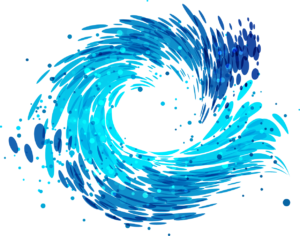by Ram
 |
| Between Clouds by Melina Meza |
Recently one of our readers of the blog posted a query about Ehlers-Danlos Syndrome (EDS) and Baxter provided the description of the disease and the precautions that needed to be taken while doing any yoga poses (see Friday Q&A: Elhers-Danlos Syndrome (EDS) and Yoga). Now here is a true account of an individual who has this genetic disease and who continues to grow strong through various modalities. Yes, yours truly has this genetic disorder. The medical diagnosis of this condition was made when I joined the Mayo Clinic for my post-doctoral research. Until then, I was the “sponge kid” to my peers in school and college.
I possess typical EDS characteristics, including hypermobile joints, swan neck deformity of fingers (the joint closest to the fingertip bends toward the palm while the nearest joint to the palm bends away from it), skin hyper-elasticity, fragile skin that tears easily, redundant skin folds, easy bruising, the Metenier Sign (eversion of the upper eye lids), the Gorlin sign (ability to touch the nose with the tongue), flat feet and passive bending of the wrist or thumb to touch the forearm. People loved to shake my hands and feel the “sponginess” of my palms. They were fascinated seeing me touch the nose with the tip of my tongue or extend the skin folds of my elbow to a couple of inches or hold the palms behind the back in a reverse prayer pose (Pashchima Namaskarasana) and extend the palms all the way up towards the rhomboid muscles.
But all of the above-mentioned stunts also came with a price. I could bruise myself very easily, as evidenced by unexplained swelling and ecchymosis (escape of blood into the tissues from ruptured blood vessels) on the palm, hand, eyes, thighs, or trunk. What for most individuals may seem to be a gentle pat on the back may result in an internal bruise for me. What may seem a gentle hit by any object will produce a blood clot and swelling in that local area for me. Opening lids from bottles may be very simple task for ordinary individuals, yet not only is it a herculean task for me, but I end up bruising my palm. If my fingers, hands, or feet encounter any rough surface, it is common to see that area swell up, turn bluish, and become painful. My grip is very weak due to the soft skin on the palm. As a result it is tough for me to hold something with a strong grip. I dread contact games like cricket, soccer, basket ball, and volleyball, among others, because invariably I end up with a multitude of internal and external bruises together with swollen areas all over the body (fluid accumulation due to the impact on the soft tissue). In one such incident involving soccer, I was the goalkeeper and saved several goals by directly heading the ball. After few such headings, my forehead swelled abnormally and I fell unconscious. It took nearly a week for the fluids to get absorbed completely.
In the early 1990’s I moved to the USA and to the Mayo Clinic to pursue my postdoctoral work. It was around this time that I started experiencing unexplained pain in the joints, probably due to excessive stretching. Furthermore, due to deficiency of collagen the ends of my bones may have been rubbing on one another irregularly because I started suffering from acute pain in the wrists, finger joints, heel, and knees. Despite possessing a fragile body condition, I agreed to go with my colleagues for what would be my first and last ski trip. At the ski resort, I had to grab hold of the rope tow to get pulled uphill. A combination of the wetness on the rope and my poor grip led me to release the rope halfway up and there I was falling and rolling down the snow slope. I ended up with swollen bruises and blood clots all over the body. This led to visits to several physicians and specialists who ordered blood tests for several parameters. All the specialists were surprised to see numerous bluish, reddish patches and clots all over my body. Finally, the rheumatologist confirmed that I suffered from EDS-Type 2. I became a poster-boy for the medical students and for the rheumatology clinic. I was advised to avoid contact sports and extreme gym exercises. Despite resorting to non-contact sports, I was always suffering from constant chronic pain. I have had this pain for so long that it sort of defined who I was and I had resigned to the fact that I to live with it.
Our move to Marin County in early 2000 provided my much needed transformation. I was introduced to Ayurveda and also found a yoga studio close to my home. The yoga practice required me to join the beginner’s level, however, my overly flexible joints served as a blessing as I was able to move seamlessly through several yoga poses, some of which required many advanced variations. Soon I transitioned from a beginner level to a mixed-level class, where we were regularly introduced to harder postures. What seemed to be a blessing in the form of hyper-flexibility now proved to be extremely challenging, as most of the teachers teaching the advanced classes were either devoted Iyengar teachers or belonged to Pattabhi’s Ashtanga yoga lineage. While my former class required props and alignment, the latter required strength, endurance, and core power. I experienced lot of problems with the rope-supported asanas in the Iyengar class due to poor grip, and I could not jump in and out of the continuous Surya Namaskara flow sequence in the Ahshtanga yoga class due to weak grip on the mat. Since my teachers were not aware of EDS and failed to see my condition, my yoga practice always ended with severe pain in the joints and limbs, and blood clots in several areas. While some of the teachers advised me to stop my practice, others suggested that I move to even higher-level class.
I soon realized I was responsible for my own safety and learned to become my own teacher. I used extreme caution to go very gradually into poses that required exceptional flexibility. I developed the qualities of dharana (focus) and dhayna (total awareness to the pose), watching every step and alignment, and taught myself to go to the edge without hurting or experiencing pain (see Samyama: The Trinity of Dharana, Dhyana, and Samadhi). I started focusing more on poses that strengthened and stabilized my major joints. In standing poses, including Warrior poses among others, I placed a lot of emphasis on engaging/contracting the muscles around the circumference of the joints while performing the pose. Despite being in a mixed-level class, I performed several of the poses by placing a block between my thighs in all of the standing poses. To prevent the block from falling in these standing poses and during Sun Salutations, I had to engage all the muscles starting from my ankles all the way up to my hips. I applied the same idea of contracting the muscles to my ankles, knees, hips, shoulders, elbows, and wrists as well. Instead of going deeply into the pose right away or twisting recklessly and trying to impress the teachers, my goal was to strengthen all my vulnerable joints. In the process I was limiting the depth of the range of movement, but I was at the same time experiencing far less pain and I was more into the ‘flow” (see Positive Psychology vs. Yoga Philosophy).
In asanas that required intense stretching, such as Parsva Uttanasana (Intense Forward Stretch), Utthita Parsvakonasana (Extended Side Angle pose), and Utthita Trikonasana (Triangle pose), I played safe by not overstretching muy front leg hip and knee joints. While leaning into the full pose, I contracted and firmed the muscles around my hip (of the front leg) and knee joint. I maintained this feeling of strength while staying in the pose and on my way out. Yes, by consciously contracting those joint, I do not go far down (and the teachers did not like it, as it was an “advanced series”) but I got to be in the pose without suffering undue pain and, most importantly, I was not hyper-extending. Suffice it to say that over the years my asana practice has now metamorphosed into a stage where the focus is not on seeking a “macho” body balancing between two rocks perched over a deep gorge. I have not only gained experience and inherently improved my skill level, but my practices have taken my skill sets to a higher state of positive experience, contentment, and a sense of accomplishment.
A combination of Ayurveda, a skillful yoga practice, pranayama, and meditation has helped me to cultivate pratyahara and find my true self. These days, whether in my home practice or in the classes I teach, I experience far less pain and very few bruises. I do develop some clots occasionally but it does not bother me anymore. I have stopped questioning why I possessed this body as I have started experiencing a positive mental-emotional balance that has resulted in improved health and happiness. I love who I am!
Follow Yoga for Healthy Aging on Facebook ° To order Yoga for Healthy Aging: A Guide to Lifelong Well-Being, go to Amazon, Shambhala, Indie Bound or your local bookstore.


This is such a powerful and touching personal story. I just wanted to reach out to Dr Roa and give him a big hug. I too have this condition and every detailed account of his pain, struggles and health issues resonates with what I have. I have been diagnosed with Type-1 EDS and my condition is still worse. I am also menopausal so the combination of lack of collagen and hormonal depletion has worsened my condition. But it's the author's story that is so powerful and encouraging that I too will not give up and go by his suggestions. Thanks Drs.
Wow, Nina that's an amazing story about how you came to yoga! I am beginning to realize we all came for a reason and isn't it wonderful that yoga has so much to offer to each one of us on our journey.